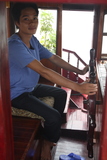
25 October 2009 – day 9 – Sunday – Hue City, Vietnam
Today we got off the junk boat
pretty early and the bus drove us back to Hanoi. I listened to music on my iPhone while we drove and, of course, watched for good photo opportunities. The usual: people conducting business in the streets, water buffalo, and motorbikes carrying everything.
One man was carrying no less than ten—maybe twelve—pigs on the back of his motorbike!
On the bus ride, Lee told us about his Vietnam war experience. He was a small child during the war, but his story was nonetheless very interesting. You see, when he was a young boy, his family lived 60 miles North of the town of Hue (pronounced “way” but with an H in front of it: “Hway.”) His town was in the DMZ, the Demilitarized Zone, which is what they called the small strip of land that separated the communist North Vietnamese army and the capitalist Saigon army that was being supported by the United States.
Lee's father worked very hard and built a beautiful brick home next to a church. This area close to Hue was rescued from starvation by Catholic missionaries in the 1700s or 1800s, and thus the people of the area were converted to Catholicism, unlike most of the country, who are Buddhist.
Because the family house was near the border between North and South Vietnam, Lee had a bomb shelter/bunker installed underneath the house, and he stocked it with food and water.
One night, Lee's mother heard the sounds of gunfire. Eventually, it got worse. She convinced her husband to flee the area, then she took the children and hid in the bunker. This was a part of the war known as the Tet offensive. Luckily, the day was a day of celebration, like a festival, so the family had bought and prepared a lot of food. They took all of the food into the bomb shelter before the fighting began.
If I got the story straight, the family hid in the bomb shelter for weeks, listening to the sounds of Vietcong (Vietnamese communist) soldiers above them. When the sounds finally stopped, they left the bunker. Several weeks went by, but they couldn't find Lee's father anywhere. After a long time, a man came into the village with several notes. One of the notes asked Lee's mother to come to the Saigon army prison and to bring his ID card.
It turns out that, because Lee's father was a sympathizer of the Saigon army, he flew to the South. Eventually he was captured by soldiers of the Saigon army, but because he had no ID card, he was put in prison. After a long time, he managed to pay a man to go to his village carrying the note.
Lee's mother took the family South, through the enemy lines, to the army prison, presented her husband's ID card and proved that he wasn't a communist, so he could get out of prison. The roads were all controlled by the Vietcong so the family had to travel by along rivers by boat, evading capture.
Lee's father tried to relocate the family back to the village, but one day, a bomber flew overhead. It dropped millions of leaflets saying that farmers should leave at once, the place was not safe. Basically, the Americans were about to bomb the area, trying to push the Vietcong back to the North.
So they left the village and relocated. Lee's father owned a tuk-tuk, so they somehow crammed father, mother and eight children, plus chickens and other livestock, all onto this one small tuk-tuk. They drove to Hue city.
Lee's mother took half the family and moved near the ocean. Lee's father took the other half of the family and moved to the mountains. Eventually they went back to their village and found it completely destroyed by bombs. There was only one small piece of the church left, and Lee's house, which was right next door, was completely gone. Completely destroyed.
They ended up moving several times and the government considered them refugees of the war.
The government relocated the family to a Saigon refugee camp, and later, into more of a building. One day, lee was making paper airplanes and throwing them out the window of the building, watching them float down to the street, when he saw something very strange. The street was green. In fact, it was covered with hundreds of soldier's uniforms. The American soldiers vacated Saigon and all the soldiers of the Saigon army took off their uniforms and ran to the hills, pretending to be farmers and such.
The Vietcong army came through and took over Saigon, winning the war for the communists, with little, if any, shooting.
It was fascinating to hear Lee talk about what his family went through. After his talk, he passed around photos of his family, their brick house, the church in his village and everything. We were all riveted to our seats listening.
When we got back to Hanoi, we stopped at a temple dedicated to the ancient Chinese philosopher Confucius.
That was interesting, and Lee gave us some background and information on Confucianism. There were rows of stelle, or big stone tablets, carved with Chinese characters on them. Each was set of the back of a giant turtle.
In a nearby pool, real turtles swam around lazily.
Eventually, after lunch at a very good restaurant that served credible American food, we drove to the airport for our flight. Now, as I write this, I'm in a beautiful hotel in Hue City (near the former DMZ) called Camellia. We had a fantastic dinner with tiny spring rolls, stir-fried chicken with ginger, and ice cream dessert. Yum!
Overloaded vehicles of the day: